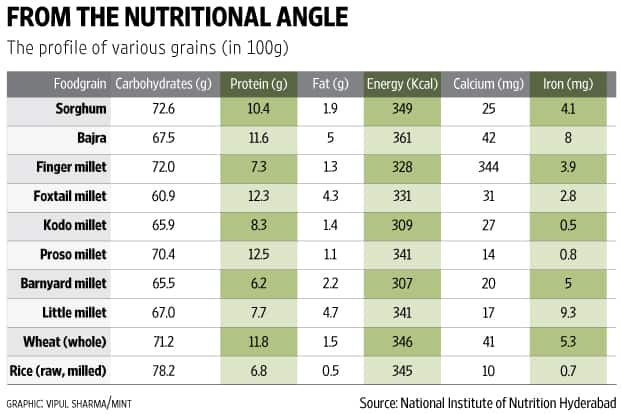Benefits of Millets
Millets fade from memory, after agricultural revolution. Most people think that millets are for the poor, not knowing its true worth. Now, thanks to many knowing its true values has become an household name again. While quinoa is touted as the most healthy food, but to buy it will surely make a hole is some people's pockets. Compared to quinoa, millets cost almost 1/10th of its price, but equally comparable to quinoa, the rich western counterpart !

Millets are coarse grains and a repository of
protein, fibre, vitamins and minerals. They include jowar (sorghum),
ragi (finger millet), korra (foxtail millet), arke (kodo millet), sama
(little millet), bajra (pearl millet), chena/barr (proso millet) and
sanwa (barnyard millet).
The practice of consuming millets as part of the
daily diet is not new to India. “Millets had been the major staple food
in central India, southern India and hilly regions of Uttarakhand for
centuries till the time of the Green Revolution. After the advent of
high-yielding varieties of rice and wheat during the 1970s, millets got
sidelined from our food basket," says a researcher. The reason for this
is lack of awareness about the nutritional benefits, the
not-so-sumptuous taste and the tag of “a poor man’s food". “Also,
government pushed only rice and wheat in the subsidized public
distribution system, rendering the cultivation of millets uneconomical,"
he says.
Globally, it found that over two billion children and adults suffer from
health problems related to being overweight or obese. In such a
scenario, gluten-free millets could prove to be an effective weapon,
believes a nutritionist .
Children learn from their parents. If we eat healthy, they will also
learn to eat healthy. Millets were part of our grandparents’ diet, it’s
only in the past few decades that their consumption has reduced. We need
to embrace the goodness of millets: Their high-fibre content helps in
bowel movement and manages diabetes and obesity. Their high magnesium
level is good for lowering blood pressure, while the potassium content
keeps hypertension at bay," says the nutritionist.
Research validates the goodness of millets. In 2010, a study said that eating korra could help bring
down blood glucose in diabetics. The same year, a research paper confirmed
that all millets are rich sources of antioxidants, while another study
in Nutrition Research concluded that millets may be useful in preventing
cardiovascular disease.

To make millets popular across India and revive
traditional food habits, Bengaluru—regarded as the millet capital—hosted
a three-day Organics and Millets National Trade Fair in April. An
initiative of the Karnataka government, the fair saw farmers, traders,
processors and exporters taking part. . “A stall of the state government
read, ‘Let’s Millet,’ along with a tag-line, ‘Next generation smart
food’, which really brought the message home. Not only are millets
healthy, they are also farmer- and eco-friendly," she says.
Compared to rice and wheat, millets need less
water and chemicals, he explains. “Besides, some millets can come up
in marginal land and harsh weather conditions where no other crop can
grow. Bajra, for instance, comes up well in the hot weather of
Rajasthan. Little millet, foxtail millet and barnyard millet are known
to assure minimum yield even in case of failure of the monsoon. So as
global warming becomes an increasingly real phenomenon, millets can
actually be a smart way of farming and eating," he says.
It’s about grain diversity
However, this doesn’t mean that you give up
wheat and rice and start eating millets. “Switching completely to
millets is not a good idea. We don’t recommend eating a single grain.
You need to mix it up depending on your health. If you are diabetic, for
instance, you can have more of ragi instead of rice or wheat. Also,
since many urban dwellers are not used to eating millets, suddenly
shifting to them is not the best idea," says a researcher.
You should slowly introduce any kind of millet
in your diet to give some “adjusting time to your digestive system",
suggests another expert. “Have it three-four times a week. You can have it as
porridge, in roti or as whole grains in the form of rice or upma. Many
people believe that millets shouldn’t be eaten in summer, which is not
quite true. As with everything else, eating in moderation is the key
(too much of millets can cause stomach ache, bloating and
constipation)," he says , adding that you should buy unpolished
millets.
The right cooking technique and a good recipe can lift any ingredient,
says an, executive chef.
“It is easy to include millets in the diet as they are very versatile.
We can have millet pancakes for breakfast, millets can be prepared like
rice, substituted for potatoes when cooked with gravy, and even make a
great addition to bread. Millets also make a great bed for roasted
vegetables and stews," he says.
India was never a two-grain nation, he says. “Our grandparents ate
all sorts of grains. We should eat everything in the right quantity, be
it rice, wheat, ragi, jowar, bajra, even quinoa (if one wants to spend
money)—because each one brings its share of goodness. The key to eating
right lies in food diversity, not becoming a victim of a food fad."
THIS IS ONLY FOR INFORMATION, ALWAYS CONSULT YOU PHYSICIAN BEFORE
HAVING ANY PARTICULAR FOOD/ MEDICATION/EXERCISE/OTHER REMEDIES.
PS-
THOSE INTERESTED IN
RECIPES ARE FREE TO VIEW MY BLOG-
https://gseasyrecipes.blogspot.com/
FOR INFO ABOUT KNEE
REPLACEMENT, YOU CAN VIEW MY BLOG-
https:// kneereplacement-stickclub.blogspot.com/
FOR CROCHET DESIGNS https://gscrochetdesigns.blogspot.com
Labels: bajra, calcium, diabetics, eco-friendly, high fibre, Iron, jowar, magneisum, millets, pancakes, porridge, protein, ragi / finger millets, versatile

0 Comments:
Post a Comment
<< Home